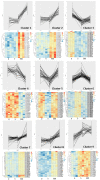Distinct Concentration-Dependent Molecular Pathways Regulate Bone Cell Responses to Cobalt and Chromium Exposure from Joint Replacement Prostheses
- PMID: 34069294
- PMCID: PMC8156984
- DOI: 10.3390/ijms22105225
Distinct Concentration-Dependent Molecular Pathways Regulate Bone Cell Responses to Cobalt and Chromium Exposure from Joint Replacement Prostheses
Abstract
Systemic cobalt (Co) and chromium (Cr) concentrations may be elevated in patients with metal joint replacement prostheses. Several studies have highlighted the detrimental effects of this exposure on bone cells in vitro, but the underlying mechanisms remain unclear. In this study, we use whole-genome microarrays to comprehensively assess gene expression in primary human osteoblasts, osteoclast precursors and mature resorbing osteoclasts following exposure to clinically relevant circulating versus local periprosthetic tissue concentrations of Co2+ and Cr3+ ions and CoCr nanoparticles. We also describe the gene expression response in osteoblasts on routinely used prosthesis surfaces in the presence of metal exposure. Our results suggest that systemic levels of metal exposure have no effect on osteoblasts, and primarily inhibit osteoclast differentiation and function via altering the focal adhesion and extracellular matrix interaction pathways. In contrast, periprosthetic levels of metal exposure inhibit both osteoblast and osteoclast activity by altering HIF-1α signaling and endocytic/cytoskeletal genes respectively, as well as increasing inflammatory signaling with mechanistic implications for adverse reactions to metal debris. Furthermore, we identify gene clusters and KEGG pathways for which the expression correlates with increasing Co2+:Cr3+ concentrations, and has the potential to serve as early markers of metal toxicity. Finally, our study provides a molecular basis for the improved clinical outcomes for hydroxyapatite-coated prostheses that elicit a pro-survival osteogenic gene signature compared to grit-blasted and plasma-sprayed titanium-coated surfaces in the presence of metal exposure.
Keywords: chromium; cobalt; gene expression; hip replacement; microarray; osteoblasts; osteoclasts; prosthesis surface.
Conflict of interest statement
The authors declare no conflict of interest.
Figures



Similar articles
-
Effects of cobalt and chromium ions at clinically equivalent concentrations after metal-on-metal hip replacement on human osteoblasts and osteoclasts: implications for skeletal health.Bone. 2011 Oct;49(4):717-23. doi: 10.1016/j.bone.2011.06.007. Epub 2011 Jun 13. Bone. 2011. PMID: 21689801
-
Cobalt and chromium exposure affects osteoblast function and impairs the mineralization of prosthesis surfaces in vitro.J Orthop Res. 2015 Nov;33(11):1663-70. doi: 10.1002/jor.22932. Epub 2015 May 18. J Orthop Res. 2015. PMID: 25929464
-
Systemic toxicity related to metal hip prostheses.Clin Toxicol (Phila). 2014 Sep-Oct;52(8):837-47. doi: 10.3109/15563650.2014.944977. Epub 2014 Aug 16. Clin Toxicol (Phila). 2014. PMID: 25132471 Review.
-
Molecular analysis of chromium and cobalt-related toxicity.Sci Rep. 2014 Jul 17;4:5729. doi: 10.1038/srep05729. Sci Rep. 2014. PMID: 25034144 Free PMC article.
-
Local and systemic toxicity of nanoscale debris particles in total hip arthroplasty.J Appl Toxicol. 2012 Apr;32(4):255-69. doi: 10.1002/jat.2729. Epub 2012 Feb 10. J Appl Toxicol. 2012. PMID: 22328167 Review.
Cited by
-
Exposome-Wide Ranking to Uncover Environmental Chemicals Associated with Dyslipidemia: A Panel Study in Healthy Older Chinese Adults from the BAPE Study.Environ Health Perspect. 2024 Sep;132(9):97005. doi: 10.1289/EHP13864. Epub 2024 Sep 6. Environ Health Perspect. 2024. PMID: 39240788 Free PMC article.
-
Cobalt-Doped Mesoporous Silica Coated Magnetic Nanoparticles Promoting Accelerated Bone Healing in Distraction Osteogenesis.Int J Nanomedicine. 2023 May 8;18:2359-2370. doi: 10.2147/IJN.S393878. eCollection 2023. Int J Nanomedicine. 2023. PMID: 37187997 Free PMC article.
-
Effect of Rehabilitation Nursing under the Guidance of the Health Action Process Approach Model on Perioperative Nursing Effect of Artificial Hip Arthroplasty: Effect on Promoting Quality of Life and Postoperative Rehabilitation.Comput Math Methods Med. 2022 Apr 12;2022:1247002. doi: 10.1155/2022/1247002. eCollection 2022. Comput Math Methods Med. 2022. Retraction in: Comput Math Methods Med. 2023 Jun 28;2023:9845958. doi: 10.1155/2023/9845958. PMID: 35465014 Free PMC article. Retracted. Clinical Trial.
-
HIF-1α Regulates Bone Homeostasis and Angiogenesis, Participating in the Occurrence of Bone Metabolic Diseases.Cells. 2022 Nov 10;11(22):3552. doi: 10.3390/cells11223552. Cells. 2022. PMID: 36428981 Free PMC article. Review.
-
Evidence-based nursing reduces complications and negative emotions and improves limb function in patients undergoing hip arthroplasty.Am J Transl Res. 2023 Mar 15;15(3):1779-1788. eCollection 2023. Am J Transl Res. 2023. PMID: 37056799 Free PMC article.
References
-
- Prentice J.R., Clark M.J., Hoggard N., Morton A.C., Tooth C., Paley M.N., Stockley I., Hadjivassiliou M., Wilkinson J.M. Metal-on-Metal Hip Prostheses and Systemic Health: A Cross-Sectional Association Study 8 Years after Implantation. PLoS ONE. 2013;8:e66186. doi: 10.1371/journal.pone.0066186. - DOI - PMC - PubMed
-
- Andrews R.E., Shah K.M., Wilkinson J.M., Gartland A. Effects of cobalt and chromium ions at clinically equivalent concentrations after metal-on-metal hip replacement on human osteoblasts and osteoclasts: Implications for skeletal health. Bone. 2011;49:717–723. doi: 10.1016/j.bone.2011.06.007. - DOI - PubMed
MeSH terms
Substances
Grants and funding
LinkOut - more resources
Full Text Sources
Miscellaneous

